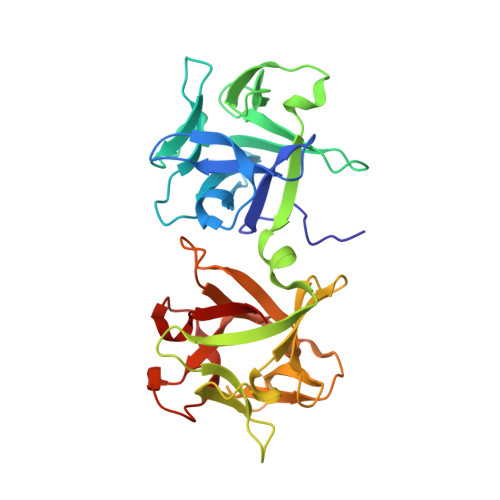Conformational divergence in the HA-33/HA-17 trimer of serotype C and D botulinum toxin complex
Sagane, Y., Hayashi, S., Akiyama, T., Matsumoto, T., Hasegawa, K., Yamano, A., Suzuki, T., Niwa, K., Watanabe, T., Yajima, S.(2016) Biochem Biophys Res Commun 476: 280-285
- PubMed: 27237978
- DOI: https://doi.org/10.1016/j.bbrc.2016.05.113
- Primary Citation of Related Structures:
5B2H - PubMed Abstract:
Clostridium botulinum produces a large toxin complex (L-TC) comprising botulinum neurotoxin associated with auxiliary nontoxic proteins. A complex of 33- and 17-kDa hemagglutinins (an HA-33/HA-17 trimer) enhances L-TC transport across the intestinal epithelial cell layer via binding HA-33 to a sugar on the cell surface. At least two subtypes of serotype C/D HA-33 exhibit differing preferences for the sugars sialic acid and galactose. Here, we compared the three-dimensional structures of the galactose-binding HA-33 and HA-33/HA-17 trimers produced by the C-Yoichi strain. Comparisons of serotype C/D HA-33 sequences reveal a variable region with relatively low sequence similarity across the C. botulinum strains; the variability of this region may influence the manner of sugar-recognition by HA-33. Crystal structures of sialic acid- and galactose-binding HA-33 are broadly similar in appearance. However, small-angle X-ray scattering revealed distinct solution structures for HA-33/HA-17 trimers. A structural change in the C-terminal variable region of HA-33 might cause a dramatic shift in the conformation and sugar-recognition mode of HA-33/HA-17 trimer.
Organizational Affiliation:
Department of Food and Cosmetic Science, Faculty of Bioindustry, Tokyo University of Agriculture, 196 Yasaka, Abashiri 099-2493, Japan. Electronic address: y3sagane@bioindustry.nodai.ac.jp.















